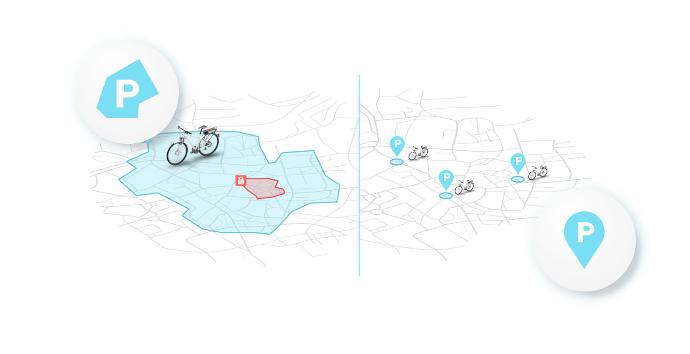Road traffic is one of the biggest sinners when it comes to CO² emissions. And these must be urgently reduced in the fight against the climate crisis. The switch to electromobility alone does not seem to be enough; a comprehensive traffic transformation is needed. What role does shared mobility play in this - and how sustainable is it?
The words of the Intergovernmental Panel on Climate Change in their latest reports sound alarming, even if they should not come as a surprise. As things stand, the 1.5°C limit could be surpassed for the first time as early as 2026, and thus much sooner than expected in previous reports. This limit represents the target set by almost all countries of the global community in the 2015 Paris Agreement: Global warming is to be limited as far as possible to 1.5°C compared with the pre-industrial era. At the very least, however, the average annual temperature globally should rise to no more than 2°C above the reference period 1850-1900.
To the IPCC Report Climate Change 2022 →
According to climate researchers, a warming of more than 1.5°C would make the consequences difficult to control and increasingly dangerous for humans and ecosystems. If this limit were to be exceeded once in the coming years, this would not mean that the climate target would be missed permanently. Nevertheless, it is clear that we are taking huge steps toward a climate crisis.
A warming of more than 1.5°C would result in rapidly rising sea levels, glaciers and ice sheets would melt, the world's oceans would acidify and we would generally be exposed to more extreme weather conditions. Around 50% of all people already live in so-called danger zones, where ecosystems could be destroyed in the future to such an extent that human life there would become impossible.
In order to limit the extent of the consequences of climate change, the Intergovernmental Panel on Climate Change recommends rapid and comprehensive climate protection at all levels. The way we travel must also play a role in this. In its climate protection program, the German government has defined the goal of reducing CO² emissions from the transport sector by around 40-42% by 2030 compared with 1990 levels - because a good 25% of global CO² emissions are caused by the transport sector, 18% by road traffic alone (as of 2018). The main polluter in transport is therefore not air traffic, as might be wrongly assumed.
What Does Sustainable Mobility Mean?
But what would have to happen to reduce emissions of pollutants from traffic? What would "sustainable mobility" mean?
In general, sustainable means that the needs of present and future generations are taken into account equally. The United Nations focuses on three essential aspects in its definition of sustainable mobility:
Mobility services and infrastructure promote the economic and social development of people, today and in the future
Mobility is "safe, affordable, accessible, efficient, and resilient"
Negative environmental damage such as from the emission of carbon dioxide, nitrogen, etc. is minimized
The discussion about sustainable mobility is generally focused on the switch to electromobility. As important and right as this is, it is not enough on its own to bring about a genuine and sustainable change in mobility. Although they do not emit any emissions while driving, this is not the case during production and electricity generation (as long as it is not 100% green electricity). What is needed is not only different vehicles, but above all fewer vehicles on the roads.

As an element of the environmental alliance, Shared Mobility reduces the burden on nature. The environmental alliance refers to the interplay of environmentally friendly modes of transportation. These include:
walking
public transport
cycling and bicycle rental systems
taking a taxi
carsharing
Especially in cities and regions with a high population density, shared mobility offerings can help relieve traffic congestion and reduce traffic-related air pollution. In 2017, the Federal Environment Agency estimated that in Germany, sharing offers that are intelligently linked to public transport can save up to 3,500 tons of CO² every day.
It is also hoped that these offers will encourage users to get rid of their private cars or not to buy a new one. Private cars are often purchased on the basis of maximum potential demand - for example, a family car should be large enough for the annual summer vacation. The rest of the year, a smaller car would be sufficient in most cases. And the fact that larger vehicles produce more emissions than smaller ones is no longer a secret.
In Shared Mobility, users select their vehicles according to their current needs. For transportation, it may be a larger car; for a trip to the lake, a small car is sufficient. The German CarSharing Association (bcs) therefore attributes it to the following reasons why carsharing cars are generally more environmentally friendly than the average private car:
→ the cars are on average more modern, smaller and more energy efficient
→ the proportion of electric cars in carsharing fleets is above average
In addition, the rates of carsharing are made up of the various cost factors and thus make the real costs of a trip visible. When using their own car, most people only calculate the acute fuel or energy costs and forget about the rest of the bill, such as acquisition, wear and tear, or maintenance. With a transparent overview of costs, however, people are more inclined to make only the really necessary journeys and to choose a sensible vehicle size.
The Blue Angel for carsharing
For more than 40 years, the Blue Angel has been the official environmental label of the German government, known for example from paper products. But the Blue Angel is also available for carsharing: Providers can get certified and put the prestigious stamp of the eco-label on their offer.
Of course, the specified criteria must be met for this to happen. These include, for example, limits on pollutant emissions, a gradual modernization of the fleet and a quota of electrically powered cars. In some municipalities, the providers then benefit from advantages such as special parking permits.
Different effects between station-based and free-floating offerings

However, there is one drawback: Station-based and free-floating sharing services do not seem to have the same effect. According to the bcs, customers of station-based services use public transport more frequently than customers of free-floating services. Station-based services are also more likely to lead to the elimination of the private car. While one station-based sharing car replaces 10 or more private cars, only three private cars are replaced in the case of free-floating.
Station-based carsharing can therefore be said to have a higher potential to change the mobility behavior of users. The exact reasons for this can only be speculated, but the reliability of station-based services probably plays a role. With these, vehicles can be reserved in advance and the pick-up locations are clearly defined. This is different from free-floating, where vehicles can be parked anywhere in the area of use and only booked spontaneously.
Locations that make sense for carsharing stations are those that are close to the user's home on the one hand and near public transport stops on the other. In this way, carsharing trips can be efficiently integrated into everyday commutes. The increasing number of mobility stations that are being built as hubs also help to make it easier to switch between modes of transport.
And What About Micro Mobility?

In the shadow of the arguments why carsharing is environmentally friendly is micro mobility. In particular, e-scooters were given a poor carbon footprint as recently as 2019 by the University of North Carolina, not least because of the material, manufacturing and - due to careless handling - short lifespan. If, in addition, the scooters are collected, redistributed and driven to the charging station by conventionally powered vehicles, the balance worsens once again.
But: A lot has happened in the last few years. According to the Shared Mobility platform, the service life of e-scooters is now at least 5 years. Also, most models now have replaceable batteries that can be easily changed. The scooters then no longer have to be collected with large transporters for charging and then distributed again.
Nevertheless, the accusation remains that the kickscooters tend to be used for distances that would otherwise have been covered on foot or by bicycle. So unlike carsharing, they do not replace private car use. At least, this is the conclusion of a study from Zurich. It also concludes from its findings that sharing e-bikes are also more likely to be used instead of public transport or one's own (non-electric) bike. According to the study, these routes would also have been covered with lower emissions in the alternative.
To judge how sustainable e-scooters & co. are, one must therefore consider the length of the trips. On shorter trips, users are more likely to substitute a walk. Longer trips, on the other hand, can be a useful supplement to other means of public transport.

So Can Shared Mobility Help In The Fight Against The Climate Crisis?
The big problem of the transport sector is the many cars on the roads and parking lots. These consume resources throughout their life cycle and take up space that could also be used for green areas, especially in cities.
The easier it becomes to use car sharing, bikesharing, etc., and the more routes and needs they cover, the more people will be able to say goodbye to their own cars in the long term. And the more people use sharing services, the greater the ecological effects. This is one of the reasons why MOQO is working to connect all the players involved in shared mobility offerings on a mobility platform and to inspire the transformation of mobility together with the providers.




